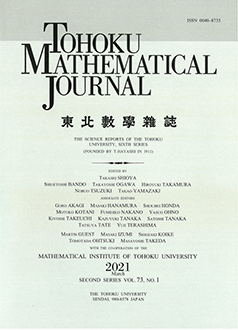Abstract
By the Fricke surfaces, we mean the cubic surfaces defined by the equation $p^2+q^2+r^2-pqr-k=0$ in the Euclidean 3-space with the coordinates $(p,q,r)$ parametrized by constant $k$. When $k=0$, it is naturally isomorphic to the moduli of once-punctured tori. It was Markoff who found the transformations, called Markoff transformations, acting on the Fricke surface. The transformation is typically given by $(p,q,r)\mapsto (r,q,rq-p)$ acting on $\boldsymbol{R}^3$ that keeps the surface invariant. In this paper we propose a way of interpolating the action of Markoff transformation. As a result, we show that one portion of the Fricke surface with $k=4$ admits a ${\rm GL}(2,\boldsymbol{R})$-action extending the Markoff transformations.
Citation
Takeshi Sasaki. Masaaki Yoshida. "Interpolation of Markoff transformations on the Fricke surface." Tohoku Math. J. (2) 60 (1) 23 - 36, 2008. https://doi.org/10.2748/tmj/1206734405
Information





